This page is a sub-page of our page on Some basic algebraic concepts.
///////
Related pages:
• Disambiguating plus
• Rings of Polynomials
///////
A binary composition \ast on a set \mathcal S is a function
{\mathcal S \times \mathcal S \ni (x, y) \, \mapsto \, x \ast y \in \mathcal S.}
The composition \ast is called associative if
(x \ast y) \ast z = x \ast (y \ast z) \, , \forall x, y, z \in \mathcal S
and \ast is called commutative if
x \ast y = y \ast x \, , \forall x, y \in \mathcal S.
If there exists an element e \in \mathcal S such that
e \ast x = x \ast e = x \, , \forall x \in \mathcal S
then e is called a unit (or unit element).
If e and e' are unit elements, then we have
e \ast e' = e = e'
Hence there is at most one unit element, i.e., a unit element is unique (if it exists).
///////
Assume that (\mathcal S, \ast) has a unit element e. Then the element x \in \mathcal S is said to have:
a left inverse, if there is an element y \in \mathcal S such that y \ast x = e.
a right inverse, if there is an element y \in \mathcal S such that x \ast y = e.
an inverse , if there is an element y \in \mathcal S such that x \ast y = y \ast x = e.
///////
Let \ast and \bullet be two binary compositions on \mathcal S. We say that:
\ast is left-distributive over \bullet if
(x \ast ( y \bullet z) = (x \ast y) \bullet (x \ast z) \, , \forall x, y, z \in \mathcal S.
\ast is right-distributive over \bullet if
(y \bullet z) \ast x = (y \ast x) \bullet (z \ast x) \, , \forall x, y, z \in \mathcal S.
\ast is distributive over \bullet if \ast is both left- and right-distributive over \bullet.
///////
Using the concepts defined above,
we can define a number of important algebraic structures:
• Semigroup: A set \mathcal S with a binary composition \ast that is associative.
• Monoid: A semigroup which has a unit element.
• Group: A monoid where each element has an inverse.
• Abelian group: A group whose binary composition is commutative.
• Ring: A set \mathcal R with two binary compositions,
called addition (denoted by + )
and multiplication (denoted by \cdot or by juxtaposition)
such that (\mathcal R, +) is an abelian group,
(\mathcal R, \cdot) is a semigroup,
and multiplication is distributive over addition.
• Ring with unit: A ring \mathcal R where (\mathcal R, \cdot) is a monoid.
• Commutative ring: A ring with commutative multiplication.
• Field: A commutative ring with unit
where each non-zero element has a multiplicative inverse.
///////
Semantics of the concepts Group, Ring, and Field:
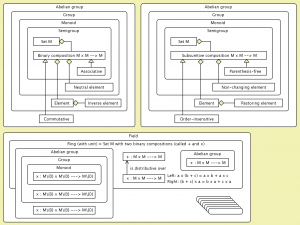
Semantics of the concepts Group, Ring, and Field (Semigroup):
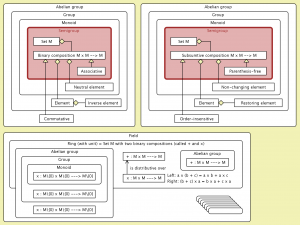
Semantics of the concepts Group, Ring, and Field (Monoid):
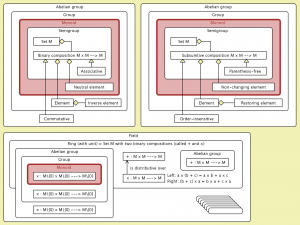
Semantics of the concepts Group, Ring, and Field (Group):
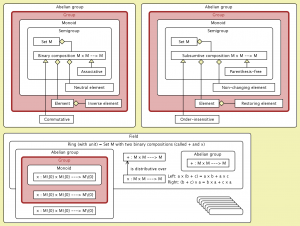
Semantics of the concepts Group, Ring, and Field (Abelian group):
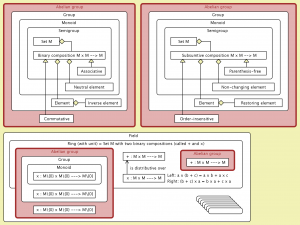
///////
Module: An abelian group (\mathcal M, \oplus) is called a module over the ring (\mathcal R, +, \cdot), or an \mathcal R – module, if there is a function
{\mathcal R \times \mathcal M \ni (r, m) \, \mapsto \, r m \in \mathcal M}, \text{ such that}
(i): 0m = 0 where 0 is the additive unit of \mathcal R.
(ii): 1m = m if \mathcal R has a multiplicative unit 1.
(iii): (r + r') m = (r m) \oplus (r' m).
(iv): r ( m \oplus m') = (r m) \oplus (r m').
(v): (r \cdot r') m = r (r' m).
Note: Most often the additive unit of \mathcal R and the additive unit of \mathcal M are both denoted by 0. Moreover, the direct sum \oplus is denoted by + and is referred to as addition.
Vector space: A module over a field.
Group homomorphism: A function {\varphi : \mathcal G \, \rightarrow \, \mathcal G'} where (\mathcal G, \ast) and (\mathcal G', {\ast}') are groups, and
\varphi ( x \ast y) = \varphi (x) {\ast}' \varphi (y), \, \forall x, y \in \mathcal G.
Module homomorphism: A function {\varphi : \mathcal M \, \rightarrow \, \mathcal M'} where \mathcal M and \mathcal M' are \mathcal R -modules and
\varphi ( rm_1 + m_2) = r \varphi (m_1) + \varphi (m_2), \, \forall r\in \mathcal R, \, \forall m_1, m_2 \in \mathcal M.
Note: The + sign to the left represents the addition in \mathcal M, while the + sign to the right represents the addition in \mathcal M'. Strictly speaking, the latter addition should be written as +'. This is a typical example of the kind of relaxation of notation that is often used in mathematics. The different meanings of a given symbol is most often clear from the context. If not, the more precise (but more cumbersome) notation can always be brought in to clear up the confusion.
Thanks for your comment.
You are quite right. The mathrehab site is very much “work in progress” and this page will be a reference page with “crisp definitions” of (some) common mathematical constructs. They will be referenced from other – hopefully more explanatory – pages on this site.
Best regards
/Ambjörn
P.S: Also, we recently updated the “template” for this site, and some of the LaTEX formulas don’t seem to work (yet) in the new setting.
Hi thank you .super
I am so grateful for your blog article.Thanks Again. Awesome.